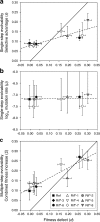Escherichia coli rpoB mutants have increased evolvability in proportion to their fitness defects
- PMID: 20106907
- PMCID: PMC2872623
- DOI: 10.1093/molbev/msq024
Escherichia coli rpoB mutants have increased evolvability in proportion to their fitness defects
Abstract
Evolvability is the capacity of an organism or population for generating descendants with increased fitness. Simulations and comparative studies have shown that evolvability can vary among individuals and identified characteristics of genetic architectures that can promote evolvability. However, little is known about how the evolvability of biological organisms typically varies along a lineage at each mutational step in its history. Evolvability might increase upon sustaining a deleterious mutation because there are many compensatory paths in the fitness landscape to reascend the same fitness peak or because shifts to new peaks become possible. We use genetic marker divergence trajectories to parameterize and compare the evolvability--defined as the fitness increase realized by an evolving population initiated from a test genotype--of a series of Escherichia coli mutants on multiple timescales. Each mutant differs from a common progenitor strain by a mutation in the rpoB gene, which encodes the beta subunit of RNA polymerase. Strains with larger fitness defects are proportionally more evolvable in terms of both the beneficial mutations accessible in their immediate mutational neighborhoods and integrated over evolutionary paths that traverse multiple beneficial mutations. Our results establish quantitative expectations for how a mutation with a given deleterious fitness effect should influence evolvability, and they will thus inform future studies of how deleterious, neutral, and beneficial mutations targeting other cellular processes impact the evolutionary potential of microorganisms.
Figures



Similar articles
-
Evolvability-enhancing mutations in the fitness landscapes of an RNA and a protein.Nat Commun. 2023 Jun 19;14(1):3624. doi: 10.1038/s41467-023-39321-8. Nat Commun. 2023. PMID: 37336901 Free PMC article.
-
Predictable properties of fitness landscapes induced by adaptational tradeoffs.Elife. 2020 May 19;9:e55155. doi: 10.7554/eLife.55155. Elife. 2020. PMID: 32423531 Free PMC article.
-
Mutations to Less-Preferred Synonymous Codons in a Highly Expressed Gene of Escherichia coli: Fitness and Epistatic Interactions.PLoS One. 2016 Jan 4;11(1):e0146375. doi: 10.1371/journal.pone.0146375. eCollection 2016. PLoS One. 2016. PMID: 26727272 Free PMC article.
-
Rational evolutionary design: the theory of in vitro protein evolution.Adv Protein Chem. 2000;55:79-160. doi: 10.1016/s0065-3233(01)55003-2. Adv Protein Chem. 2000. PMID: 11050933 Review.
-
Mechanisms and selection of evolvability: experimental evidence.FEMS Microbiol Rev. 2013 Jul;37(4):572-82. doi: 10.1111/1574-6976.12008. Epub 2012 Nov 15. FEMS Microbiol Rev. 2013. PMID: 23078278 Review.
Cited by
-
Benefit of transferred mutations is better predicted by the fitness of recipients than by their ecological or genetic relatedness.Proc Natl Acad Sci U S A. 2016 May 3;113(18):5047-52. doi: 10.1073/pnas.1524988113. Epub 2016 Apr 18. Proc Natl Acad Sci U S A. 2016. PMID: 27091964 Free PMC article.
-
Experimental Evolution Expands the Breadth of Adaptation to an Environmental Gradient Correlated With Genome Reduction.Front Microbiol. 2022 Jan 26;13:826894. doi: 10.3389/fmicb.2022.826894. eCollection 2022. Front Microbiol. 2022. PMID: 35154062 Free PMC article.
-
Genomic investigations of evolutionary dynamics and epistasis in microbial evolution experiments.Curr Opin Genet Dev. 2015 Dec;35:33-9. doi: 10.1016/j.gde.2015.08.008. Epub 2015 Sep 14. Curr Opin Genet Dev. 2015. PMID: 26370471 Free PMC article. Review.
-
Dynamic mutation-selection balance as an evolutionary attractor.Genetics. 2012 Aug;191(4):1309-19. doi: 10.1534/genetics.112.141291. Epub 2012 Jun 1. Genetics. 2012. PMID: 22661327 Free PMC article.
-
Polyploidy can drive rapid adaptation in yeast.Nature. 2015 Mar 19;519(7543):349-52. doi: 10.1038/nature14187. Epub 2015 Mar 2. Nature. 2015. PMID: 25731168 Free PMC article.
References
-
- Ahrens JH, Dieter U. Computer generation of Poisson deviates from modified normal distributions. ACM Trans Math Software. 1982;8:163–179.
-
- Barrick JE, Yu DS, Yoon SH, Jeong H, Oh TK, Schneider D, Lenski RE, Kim JF. Genome evolution and adaptation in a long-term experiment with Escherichia coli. Nature. 2009;461:1243–1247. - PubMed
-
- Bebbington AC. A simple method of drawing a sample without replacement. Appl Statist. 1975;24:136.
Publication types
MeSH terms
Substances
Grants and funding
LinkOut - more resources
Full Text Sources
Other Literature Sources

